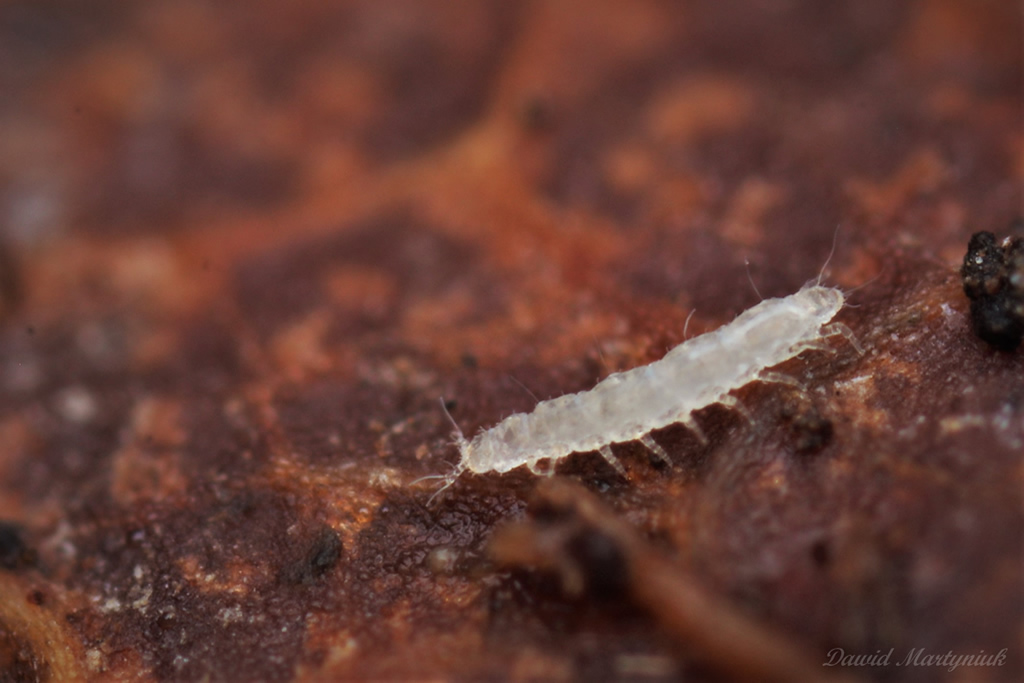Allopauropus gracilis (Hansen, 1902)
Synonyms
ID Difficulty
Identification
A common Pauropod of typical length (~1mm) but atypically thin (~0.2mm), making them appear much smaller than most other Pauropods. As in other members of the Allopauropus genus, the anterior margin of the antennal sternal branch is shorter than the posterior margin. In this species, the anterior flagellum of the sternal branch is approximately half as long as the posterior flagellum, and the pygidial sternite (underside of the last segment) lacks the b3 (sternal-central) setae, as in other species of the subgenus Decapauropus, but b3 setae are present in subgenus Allopauropus.
All Pauropod species have a distinct anal plate (small structure located at the lower, most posterior point of the pygidium) which in this species is relatively round, with two small lobes at the posterior end and a pair of long, diverging appendages positioned laterally. This structure can only be seen clearly at >800x magnification.
Distribution
Allopauropus (Decapauropus) gracilis is the most widespread species in the UK (Scheller 1990) and believed to be subcosmopolitan, found in most of Europe and beyond such as Sri Lanka, USA, Chile, and Northern Africa.
Published records (not included on the NBN) are given for Dorset, Somerset (Remy 1961), Hampshire (Scheller 1990), Surrey (Bagnall 1935), Berkshire (Scheller 1974), London (Bagnall 1935), Gloucestershire (Scheller 1974), Essex (Bagnall 1935), Leicestershire (Scheller 1990), Lincolnshire (Scheller 1974), Lancashire (Bagnall 1916), North Yorkshire (Bagnall 1935), Durham (Bagnall 1909), Northumberland (Bagnall 1909), South Glamorgan (Scheller 1990), Lothian (Bagnall 1935) and Strathclyde (Remy 1961).
As with all pauropods this is a small and very elusive species, and consequently extremely under-recorded.
Habitat
This species can be found in a wide range of habitats, from mixed woodland to agricultural land in damp soil and deciduous rotting wood, but also under rotting bark and logs (Scheller 1990), especially those slightly sunken into the soil. Similarly to other Pauropods, Allopauropus gracilis is dependent on moisture, so may be less common on the surface in dry conditions, and instead found underground e.g. at 20-30cm depth in agricultural soil (Hüther 1974). In humid habitats or after rain, they may move closer to the surface where they are more common under wet bark and within the outer layers of rotting wood.
There is currently no recording scheme for Pauropods in Britain and Ireland, but this is likely to change in the future.
References
Scheller,U. (1990). A list of the British Pauropoda with a description of a new species of Eurypauropodidae (Myriapoda). Journal of Natural History 24: 1179-1195.
Scheller,U. (2008). A reclassification of the Pauropoda (Myriapoda). International Journal of Myriapodology 1(1):1–38.
Andersson, G., Bjarne, M., Scheller, U., Djursvoll, P., Budd, G. & Gärdenfors, U. (2005). Mangfotingar. Myriapoda. ArtDatabanken, Sveriges lantbrukuniversitet.
Hüther, W. (1974). Zur Bionomie mitteleuropäischer Pauropoden. In: Blower, J.G. (ed.) Myriapoda. 2nd International Congress of Myriapodology, Manchester, 5-12 April, 1972. Sympsia of the Zoological Society of London. 32: 411-412.
Barber, A.D., Blower, J.G., Scheller, U. (1992). Pauropoda, the smallest myriapods. Bulletin of the British Myriapod Group 8: 13-24.
Links
MilliBase - Global catalogue of Pauropods: https://millibase.org/aphia.php?p=taxdetails&id=1006157






